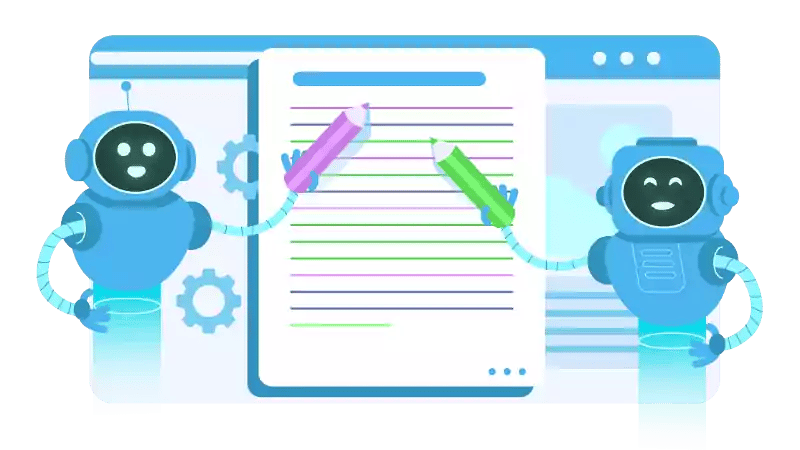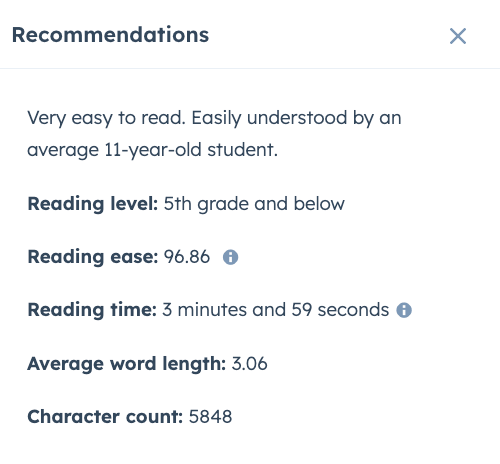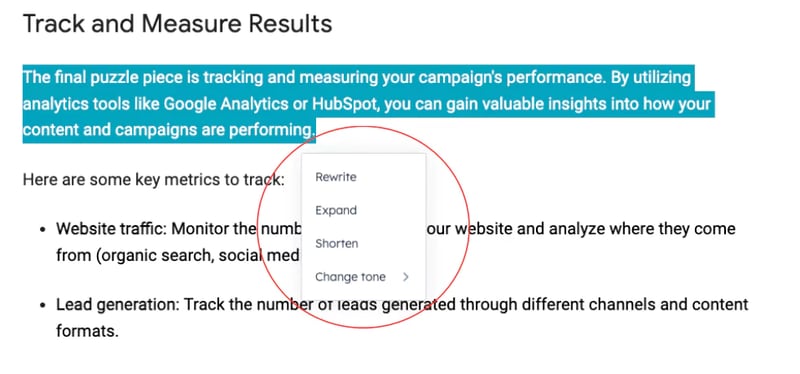Conținut ușor de citit? La ce nivel ar trebui să fie?
Ați petrecut vreodată ore întregi creând mesajul de marketing perfect, doar pentru a auzi greieri? Conținutul dvs. ar putea fi genial, dar dacă se citește ca un manual universitar, publicul dvs. va trece peste el mai repede decât puteți spune "angajament". Aici intervinenivelul de lizibilitate. Este cheia pentru deblocarea unei comunicări clare, biletul de aur pentru ca conținutul dvs. să se conecteze cu adevărat și să rezoneze cu cititorii.

De ce contează lizibilitatea?
În era supraîncărcării cu informații, captarea și reținerea atenției este o luptă constantă pentru specialiștii în marketing. Crearea mesajului perfect este inutilă dacă publicul se pierde în propoziții complicate și jargon complex. Aici intră în joc nivelul de lizibilitate. Este vorba despre asigurarea faptului că conținutul dvs. este ușor de înțeles și captivant, ceea ce conduce la rezultate mai bune în marketing. Iată cum comunicarea clară se traduce prin succes:
Angajament și conversii îmbunătățite
Imaginați-vă că parcurgeți fluxurile nesfârșite de pe rețelele sociale, bombardat cu informații. Brusc, un mesaj clar și concis vă captează atenția. Te trezești citind mai departe, intrigat de curgerea ușoară a cuvintelor și de simplitatea mesajului. Aceasta este puterea conținutului ușor de citit. Acesta atrage audiența, permițându-i să digere informațiile fără efort. Acest lucru se traduce printr-un angajament sporit: mai mult timp de lectură, o interacțiune mai mare cu conținutul dvs. și o înțelegere mai profundă a mesajului dvs.
În plus, comunicarea clară duce la creșterea conversiilor. Atunci când cititorii înțeleg mesajul dvs. fără efort, este mai probabil ca aceștia să întreprindă acțiunea dorită, fie că este vorba de abonarea la buletinul dvs. informativ, descărcarea unei cărți albe sau efectuarea unei achiziții. Gândiți-vă la aceasta ca la un apel la acțiune: cu cât este mai ușor de înțeles apelul, cu atât este mai probabil ca oamenii să răspundă.
Îmbunătățirea imaginii mărcii și a încrederii
Limbajul complex și jargonul pot crea un aer de sofisticare, dar adesea creează o barieră între marca dvs. și publicul dvs. Conținutul lizibil, pe de altă parte, favorizează transparența și accesibilitatea. Arată publicului dumneavoastră că apreciați timpul și înțelegerea acestuia și că sunteți încrezător în mesajul dumneavoastră, fără a recurge la o complexitate inutilă. Acest lucru favorizează un sentiment de încredere și credibilitate, poziționându-vă brandul ca fiind de încredere și accesibil.
În plus, comunicarea clară demonstrează respect pentru inteligența publicului dumneavoastră. Ei nu au nevoie să li se vorbească de sus sau să fie copleșiți cu termeni tehnici. Acest lucru favorizează o percepție pozitivă a mărcii, ceea ce face ca publicul dvs. să vadă marca dvs. ca fiind demnă de încredere și fiabilă.
Audiență mai largă și accesibilitate
Nu toată lumea are același nivel de înțelegere a cititului, iar audiențele diverse sunt o realitate pentru majoritatea brandurilor din prezent. Conținutul lizibil se adresează unui public mai larg, asigurând că mesajul dvs. ajunge la o gamă mai largă de potențiali clienți, indiferent de nivelul lor educațional sau de citire. Acest lucru se traduce prin creșterea notorietății brandului și a intrării pe piață.
În plus, comunicarea clară este inclusivă și accesibilă persoanelor cu dificultăți de învățare sau celor care nu vorbesc engleza ca primă limbă. Simplificându-vă scrisul, vă asigurați că toată lumea are ocazia să vă înțeleagă mesajul și să se implice cu marca dumneavoastră. Acest lucru demonstrează un angajament față de incluziune și favorizează asocierile pozitive cu marca.
Conținutul clar și concis nu este doar o chestiune de estetică; este vorba despre o comunicare strategică care oferă beneficii tangibile. Prin prioritizarea lizibilității, îmbunătățiți implicarea publicului, îmbunătățiți imaginea mărcii și ajungeți la un public mai larg, propulsându-vă eforturile de marketing către un succes mai mare.
Înțelegerea nivelurilor de lizibilitate
Poate că vă gândiți: Pot să-mi înțeleg scrisul, dar cum pot ști dacă este ușor de înțeles și pentru alții? Intră în scenă metricile de lizibilitate: un set de instrumente concepute pentru a cuantifica complexitatea scrierii dumneavoastră. Aceste măsurători oferă informații valoroase și vă ajută să vă adaptați conținutul la nivelul de citire al publicului țintă.
Există doi indicatori comuni de lizibilitate:
-
Flesch-Kincaid Grade Level: Această măsură populară atribuie textului dvs. un echivalent de nivel de clasă (de exemplu, clasa a 8-a) pe baza unor factori precum lungimea propoziției și numărul de silabe. În general, un nivel inferior indică o lectură mai ușoară.
-
Indicele Gunning Fog: Similar scorului Flesch-Kincaid, indicele Gunning Fog ia în considerare lungimea și complexitatea propozițiilor (pe baza unui număr mediu de cuvinte pe propoziție și a procentului de cuvinte complexe cu trei sau mai multe silabe). Un scor mai scăzut semnifică o înțelegere mai ușoară a lecturii.
Deși aceste formule oferă un scor numeric, este important să rețineți că acestea sunt estimări, nu măsurători absolute. Ele nu țin cont de factori precum înțelegerea culturală, tonul și contextul specific al scrierii dumneavoastră.
Adaptarea lizibilității la publicul dumneavoastră
Cunoașterea publicului țintă este regula de aur în marketing și se aplică în egală măsură creării de conținut relevant. Înțelegerea persoanei pentru care scrieți vă ajută să găsiți echilibrul corect între informativ și captivant, ceea ce duce în cele din urmă la un impact mai mare.
Așadar, cum intervine publicul țintă în alegerea nivelului de lectură potrivit? Imaginați-vă că încercați să explicați unui copil concepte financiare complexe folosind un vocabular sofisticat. Este foarte probabil să le treacă prin cap și să rămână pierduți. În mod similar, bombardarea unui public foarte educat cu un limbaj de bază ar putea părea condescendentă și nu i-ar capta atenția.
De aceea, este esențial să adaptați nivelul de lectură la așteptările și capacitatea de înțelegere a publicului dumneavoastră. În general, ideal pentru majoritatea conținutului de marketing este să se urmărească un nivel de lectură de clasa a V-a sau mai mic.
La Aspiration Marketing, ne propunem ca scrisul nostru să fie orientat către acest nivel de citire. Considerăm că un nivel de clasa a cincea este ușor de înțeles pentru majoritatea publicului nostru, mai ales având în vedere că ne adresăm unui public divers din punct de vedere geografic, astfel încât engleza nu este întotdeauna prima limbă a tuturor.
Această recomandare provine din două motive principale:
-
Accesibilitate: Un nivel de citire mai scăzut asigură faptul că mesajul dvs. ajunge la un public mai larg, indiferent de nivelul lor educațional sau de fluența în citire. Acest lucru este deosebit de important pentru mărcile care doresc să se conecteze cu audiențe diverse.
-
Implicare: Limbajul mai simplu este mai ușor de înțeles și asimilat, ceea ce duce la un angajament sporit față de conținutul dvs. Cititorii sunt mai predispuși să rămână implicați și să rețină informațiile atunci când acestea sunt prezentate într-un mod clar și concis.
Cu toate acestea, este important să rețineți că "clasa a 5-a sau mai mică" este un ghid general, nu o regulă rigidă.
Iată de ce testarea și ajustarea sunt vitale:
-
Tipul de conținut: O lucrare tehnică destinată profesioniștilor din industrie ar putea necesita un nivel de citire mai ridicat decât o postare pe rețelele sociale destinată unui public general.
-
Informații despre publicul țintă: Dacă dispuneți de date specifice privind datele demografice și nivelul de educație al publicului dumneavoastră, puteți adapta nivelul de citire în consecință.
-
Testare și analiză: Instrumente precum testarea A/B vă pot ajuta să comparați performanța conținutului scris la diferite niveluri de citire și să determinați ce rezonează cel mai bine cu publicul dumneavoastră.
HubSpot are câteva sfaturi excelente și chiar recomandări în timp real dacă vă străduiți să vă aduceți scrisul la acest nivel. Luați în considerare următoarele:
-
Țintește-ți publicul: Înțelegeți nivelul de lectură și preferințele cititorului dvs. ideal. Vizați conținut care rezonează cu ei și se aliniază așteptărilor lor.
-
Prioritizați claritatea: Utilizați un limbaj simplu, evitați jargonul și asigurați-vă că mesajul dvs. este ușor de înțeles.
-
Împărțiți informațiile complexe: Utilizați bullet points, subtitluri și elemente vizuale pentru a descompune conceptele complexe în bucăți mici.
-
Variați lungimea propozițiilor: Nu cădeți în capcana structurii monotone a propozițiilor. Amestecați propoziții scurte și lungi pentru a crea un flux natural.
-
Scrieți în mod natural: Evitați conversaționalismul forțat sau limbajul excesiv de formal. Vizați o voce autentică care să se conecteze cu publicul dumneavoastră.
Dacă scrieți în HubSpot, platforma va genera automat aceste recomandări și vă va revizui scrisul:

Dorim să reiterăm faptul că contextul contează. Un white paper tehnic destinat profesioniștilor din industrie ar putea necesita un nivel de lectură mai ridicat în comparație cu un blog general (ca acesta) scris pentru a ajuta cititorii să înțeleagă un subiect sau o idee nouă.
Dacă aveți nevoie de mai multă asistență decât aceste sfaturi, asistentul AI al HubSpot vă poate ajuta să clarificați, să condensați și să generați conținut.
Sau, cu o simplă solicitare, puteți cere asistentului să genereze conținut aliniat la nivelul de citire dorit.
Instrumente pentru măsurarea lizibilității
Deci, ați înțeles importanța unei comunicări clare și necesitatea de a vă adapta conținutul la publicul țintă. Dar cum vă asigurați că scrierea dvs. atinge ținta? Aici sunt utile instrumentele de măsurare a lizibilității.
Există resurse online disponibile gratuit care vă analizează scrisul și vă oferă informații despre complexitatea acestuia, ajutându-vă să identificați domeniile în care trebuie să vă îmbunătățiți. Deși nu înlocuiesc propria judecată, aceste instrumente oferă îndrumări valoroase pentru a vă asigura că mesajul dvs. este clar și ușor de înțeles.
Iată o privire asupra unor opțiuni populare:
-
Hemingway Editor: Acest instrument ușor de utilizat evidențiază propozițiile complexe, adverbele și vocea pasivă. Acesta atribuie un cod de culori (verde fiind cel mai simplu, roșu fiind cel mai complex) diferitelor secțiuni, facilitând identificarea vizuală a potențialelor puncte problematice.
-
Flesch-Kincaid Grade Level: Acest instrument calculează echivalentul nivelului de clasă al textului dvs. scris, oferind o idee generală a gradului de înțelegere a cititului necesar pentru a-l înțelege.
-
Analiza lizibilității Yoast SEO: Acest plugin, utilizat în principal pentru optimizarea conținutului pentru motoarele de căutare, include și o funcție de analiză a lizibilității. Aceasta oferă sugestii pentru îmbunătățirea lungimii propozițiilor, a structurii propozițiilor și a utilizării vocii pasive.
Rețineți, aceste instrumente nu sunt menite să vă dicteze stilul de scriere, ci mai degrabă să vă ghideze în crearea unui conținut clar și concis. Iată cum să le interpretați rezultatele și să le folosiți în avantajul dumneavoastră:
-
Concentrează-te pe imaginea de ansamblu: Nu vă lăsați împotmoliți de obținerea unui anumit scor. Utilizați feedback-ul pentru a identifica zonele în care scrierea dvs. ar putea fi prea complexă sau greu de înțeles.
-
Abordați zonele evidențiate: Acordați atenție propozițiilor marcate ca fiind complexe, adverbelor excesive și utilizării vocii pasive. Luați în considerare restructurarea propozițiilor, înlocuirea jargonului cu termeni mai simpli și utilizarea vocii active pentru un flux mai captivant.
-
Citiți-vă conținutul cu voce tare: Această practică simplă vă poate ajuta să identificați frazele incomode sau zonele care ar putea deruta cititorii. Faptul că vă auziți citind poate dezvălui complexități ascunse pe care le-ați putea omite citind în tăcere.
Nu uitați, în loc să vă concentrați exclusiv pe obținerea unui scor specific, folosiți instrumentele de lizibilitate ca ghiduri pentru a identifica zonele de îmbunătățire și pentru a vă asigura că conținutul dvs. este ușor de înțeles pentru publicul țintă. Scopul este de a comunica eficient, nu de a obține scorul "perfect".
Lista de verificare pentru un conținut ușor lizibil
-
Vizați publicul dumneavoastră: Pentru cine scrieți? Adaptați limbajul și complexitatea la așteptările și nivelul lor de cunoștințe.
-
Vizați claritatea: Utilizați un limbaj simplu, evitați jargonul și asigurați-vă că mesajul dumneavoastră este ușor de înțeles.
-
Descompuneți informația: Împărțiți informațiile complexe în fragmente mici, folosind bullet points, subtitluri și elemente vizuale.
-
Variați propozițiile: Combinați propoziții scurte și lungi pentru un flux natural.
-
Citiți cu voce tare: Sună bine și natural? Acest lucru ajută la identificarea frazelor incomode.
-
Concentrați-vă pe vocea activă: Vocea activă face ca scrisul dvs. să fie mai captivant și mai ușor de urmărit.
-
Folosiți cuvinte de tranziție: Tranzițiile line între propoziții îmbunătățesc lizibilitatea și fluiditatea.
-
Corectați și editați: Asigurați-vă că conținutul dvs. este lipsit de erori gramaticale și de greșeli de scriere.
-
Măsurați lizibilitatea: Utilizați instrumente online precum Hemingway Editor sau Flesch-Kincaid pentru a obține o indicație a complexității. Nu uitați, acestea sunt ghiduri, nu absolute.
-
Testați și ajustați: Experimentați cu abordări diferite și vedeți ce rezonează cel mai bine cu publicul dumneavoastră.
Urmând aceste sfaturi și folosindu-vă judecata, puteți crea conținut bun, informativ și captivant pentru publicul dvs.
Comunicarea clară: Piatra de temelie a marketingului de conținut
Lizibilitatea are un impact uriaș asupra succesului marketingului de conținut. Comunicarea clară favorizează implicarea, creează încredere și vă extinde raza de acțiune, propulsându-vă brandul.
Este important să asigurați o claritate consecventă în ceea ce scrieți, așa că luați în considerare stabilirea unor linii directoare interne pentru dvs. sau echipa dvs., cum ar fi țintirea unui anumit nivel școlar și a unui scor minim de ușurință în citire (care urmează să fie stabilit pe baza unei analize suplimentare).
Dacă aveți nevoie de mai mult ajutor pentru a vă simplifica conținutul, pentru a aduce conținutul în fața publicului sau pentru a crea conținut, luați în considerare parteneriatul cu Aspiration Marketing pentru serviciile noastre de marketing de conținut!
Acest conținut este disponibil și în:
- Germană: Ist Ihr Inhalt leicht zu lesen? Welches Niveau sollte er haben?
- Engleză: Is Your Content Easy to Read? What Level Should It Be?
- Spaniolă: ¿Es su contenido fácil de leer? ¿Qué nivel debe tener?
- Franceză: Votre contenu est-il facile à lire ? À quel niveau doit-il se situer ?
- Italiană: Contenuto leggibile: a che livello?
- Chineză: 您的内容是否易于阅读?应该达到什么程度?












Lasă un comentariu cu părerea ta.